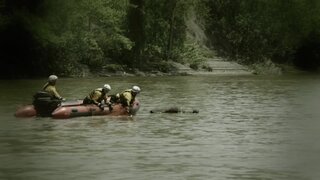Create a free profile to get unlimited access to exclusive videos, breaking news, sweepstakes, and more!
How Gary Ridgway, ‘The Green River Killer,’ Was Captured With Nearly 20-Year-Old DNA Evidence
Gary Ridgway claimed to have murdered up to 80 victims, which would make him the most prolific serial killer in U.S. history.
Murders A-Z is a collection of true crime stories that take an in-depth look at both little-known and famous murders throughout history.
Known as “The Green River Killer,” Gary Ridgway was convicted of murdering 49 women in Washington State in the early 1980s. Until the emergence of Samuel Little, who has been linked to 60 murders and confessed to nearly 100, he was thought to be America’s most prolific murderer.
In recent years, Ridgway has claimed he killed as many as 80 victims, but he said he can’t be sure.
“I killed so many women, I have a hard time keeping them straight,” he said at his sentencing in 2003, according to the Los Angeles Times.
He had been a suspect in the slayings as far back as 1983, but it would take almost 20 years before DNA technology would be able to pin the crimes on him.
Who Is Green River Killer Gary Ridgway?
Gary Leon Ridgway was born in Salt Lake City, Utah, in 1949. When he was 11, his family moved to King County, Washington, which includes Seattle and its satellite communities. When he was 15, Ridgway stabbed a first-grade boy, according to The Seattle Times. He told a psychologist he frequently fantasized about stabbing people, including his mother, to whom he said he was sexually attracted, reported The Washington Post.
In 1969, Ridgway enlisted in the U.S. Navy. While stationed in the Philippines, he began frequenting sex workers, eventually contracting gonorrhea, according to The News Tribune in Tacoma. He married in 1970, but the marriage only lasted a year. Upon his discharge from the Navy, he became a highly skilled painter at Kenworth Trucks. After his second marriage in 1973, Ridgway had a son Matthew, who has spoken out about turmoil caused by his father's crimes.
Ridgway’s second wife filed for divorce in summer 1980 and sought a restraining order against him, according to The News Tribune. She told investigators he enjoyed rough sex and once put her in a chokehold. The following year, he bought a ranch home in the city of SeaTac, Washington. He would later admit dozens of women were murdered there, reported the News Tribune.
Ridgway was obsessed with sex, and one girlfriend said he demanded it daily, according to Seattle Weekly. He was stopped by police and arrested multiple times for solicitation, reported the Los Angeles Times.
In July 1982, two boys playing near Washington’s Green River discovered Ridgway’s first known victim, Wendy Coffield, age 16, according to The News Tribune. Throughout the summer, bodies began turning up in the river at an alarming rate, hence Ridgway’s nickname. Though many of his murders occurred in 1982 and 1983, Ridgway wouldn’t stop until 1998, when he killed his last known victim, 38-year-old Patricia Yellowrobe.
Most of Ridgway’s victims were either sex workers or runaways from the Seattle metropolitan area. They were not confined to a single race or ethnicity, but they were all generally young and slender. He would rape his victims and then strangle them, either with his hands or a ligature, reported The New York Times.
“I was pretty good at it," he bragged to investigators, according to The Washington Post. After disposing of their bodies in the dense forests of the Pacific Northwest, he would sometimes return to have sex with the corpses.
Ridgway came to the attention of police as early as spring 1983, when victim Marie Malvar was seen getting into his pickup truck. He was questioned by police, but denied knowing Malvar, according to the Seattle Post-Intelligencer. Her remains were found in 2003 after Ridgway instructed police where to find them.
In January 1984, the 55-member Green River Task Force was formed to investigate the murders. Due to his previous arrests and his connection to the Malvar disappearance, Ridgway was in regular contact with detectives. That spring, he agreed to take a polygraph test, during which he denied killing any women and passed, according to The Seattle Times.
Despite the lack of hard evidence, Ridgway remained a person of interest and was placed on surveillance for two weeks in fall 1986. In April 1987, police obtained a warrant to search Ridgway’s home and vehicles, reported The News Tribune. They found nothing of value to the investigation and nothing to merit an arrest.
Before leaving, however, they had Ridgway chew on a piece of gauze to provide a saliva sample, according to The Washington Post.
Over the next decade, Ridgway was free to marry and kill again, but King County Sheriff Dave Reichert, one of the original investigators of the Green River Killer murders, said Ridgway remained "one of the top five suspects," according to The Washington Post.
Without any evidence, though, there was little that could be done.
How Was The Green River Killer Caught?
In fall 2001, Ridgway was arrested on charges of loitering for the purpose of soliciting a sex worker, according to The News Tribune.
Thanks to new technological breakthroughs, forensic investigators were able to reexamine Ridgway’s DNA sample. They compared DNA found in the sperm of three of the Green River Killer’s earliest victims to their swab of Gary Ridgway’s saliva, which had been kept in storage since 1987.
"And guess what? The charts were all the same," Reichert said, according to The Washington Post.
The DNA match linked Ridgway to the murders of Opal Mills, Marcia Chapman and Cynthia Hinds, whose bodies were found together in the Green River in summer 1982, and Carol Christensen, who was found in woods nearby in May 1983, according to the Los Angeles Times.
Police arrested Ridgway when he got off work on Nov. 30, 2001. On Dec. 5, he was charged with four counts of aggravated first-degree murder, according to The News Tribune. Before the start of his trial, Ridgway was charged with three additional counts of murder for the deaths of Wendy Coffield and two others.
Who Were The Green River Killer Victims?
On Nov. 5, 2003, Gary Ridgway appeared in a packed courtroom filled with members of his victims’ families and pleaded guilty to 48 murders, the most ever admitted to by a serial killer in the United States, according to the Los Angeles Times. In exchange for pleading guilty, he was spared the death penalty.
The previous summer, Ridgway had begun cooperating with police and leading them to his secret burial sites. On Dec. 18, 2003, Ridgway was sentenced to 48 consecutive life terms in prison and fined $480,000 — $10,000 for each victim, according to CNN.
Ridgway’s victim count, however, continued to grow, and he received his 49th life sentence in 2011, after confessing to the 1982 murder of Rebecca Marrero, according to Reuters. Ridgway had previously confessed to her murder, but prosecutors couldn’t pursue charges due to a lack of evidence. Her remains were discovered by teenagers in 2010.
From behind bars, Ridgway has alleged there are even more bodies to be found. In a series of interviews with Seattle radio station KOMO from 2013, Ridgway insisted his true body count was between 75 and 80. He claims if he was able to take investigators to where he buried his victims, they would be able to identify more of their remains.
Authorities, however, are skeptical. King County Sheriff's Sgt. Katie Larson, who was involved in the investigation, told NBC News, "Everything Ridgway's saying we've heard before, time and time and time again."
In 2021, one of the first victims to be found in 1984 was finally identified, having been called "Bones 10" since her remains were located in a Washington state baseball field. Forensic scientists from the DNA Doe Project determined the remains belonged to Wendy Stephens, a 14-year-old runaway from Colorado, Oxygen.com reported.
Is The Green River Killer Still Alive?
Ridgway, now in his 70s, is currently being held at Washington State Penitentiary in Walla Walla.
During the coronavirus pandemic, Ridgway was one of 12,000 Washington state inmates who requested to be released from custody amid the outbreak. The request was denied following a 5-4 ruling.
Want to learn more about the minds of serial killers? Watch the true crime series "Method of a Serial Killer" on Oxygen.com.
(This story was originally published on September 18, 2019 and has been updated with new information.)




































